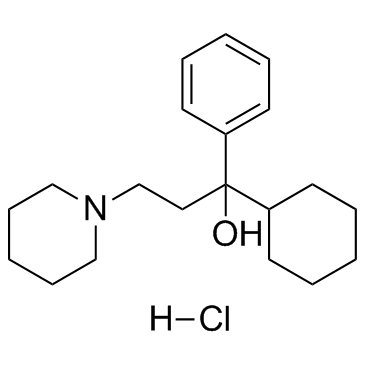Anti-cholinergics for axial symptoms in Parkinson's disease after subthalamic stimulation.
Yasuhiko Baba, Masa-Aki Higuchi, Hiroshi Abe, Kouzou Fukuyama, Rieko Onozawa, Yoshinari Uehara, Tooru Inoue, Tatsuo Yamada
Index: Clin. Neurol. Neurosurg. 114(10) , 1308-11, (2012)
Full Text: HTML
Abstract
We studied the effect of anti-cholinergic therapy on axial symptoms that show a tendency to worsen over time after deep brain stimulation of the subthalamic nucleus (STN-DBS) in patients with Parkinson's disease (PD).We conducted a prospective study of 20 consecutive patients treated with the anti-cholinergic agent trihexyphenidyl after bilateral STN-DBS and assessed the effect of anti-cholinergic therapy on parkinsonism 1 month after its initiation using the Unified Parkinson's Disease Rating Scale (UPDRS).After a mean post-operative follow-up period of 22.3 months, the scores of axial symptoms on UPDRS part II (ADL score) and part III (motor score) deteriorated by 87% and 54% (baseline), respectively, compared with the pre-operative scores (P < 0.001 for both comparisons). After adding trihexyphenidyl to dopaminergic medication with stimulation, the scores of axial symptoms on UPDRS part II and part III improved from baseline by 33% and 39%, respectively (P < 0.001 for both comparisons).Our findings demonstrated that the anti-cholinergic agent trihexyphenidyl shows positive effect for a patient population developing deterioration of axial symptoms after STN-DBS. The results in the present study may provide insights into the mechanism of emergence or progression of axial symptoms in patients with PD after STN-DBS.Copyright © 2012 Elsevier B.V. All rights reserved.
Related Compounds
| Structure | Name/CAS No. | Molecular Formula | Articles |
|---|---|---|---|
 |
Benzhexol hydrochloride
CAS:52-49-3 |
C20H32ClNO |
|
Gingival pain: an unusual side effect of ziprasidone.
2013-01-01 [BMJ Case Rep. 2013 , doi:10.1136/bcr-2012-007577, (2013)] |
|
A misguided 'pill in the pocket' approach with flecainide le...
2012-01-01 [BMJ Case Rep. 2012 , doi:10.1136/bcr-2012-006868, (2012)] |
|
DYT16: the original cases.
2012-10-01 [J. Neurol. Neurosurg. Psychiatr. 83(10) , 1012-4, (2012)] |
|
Management of status dystonicus in children. Cases report an...
2012-07-01 [Eur. J. Paediatr. Neurol. 16(4) , 390-5, (2012)] |
|
An anticholinergic reverses motor control and corticostriata...
2012-01-15 [Behav. Brain Res. 226 , 465-72, (2012)] |